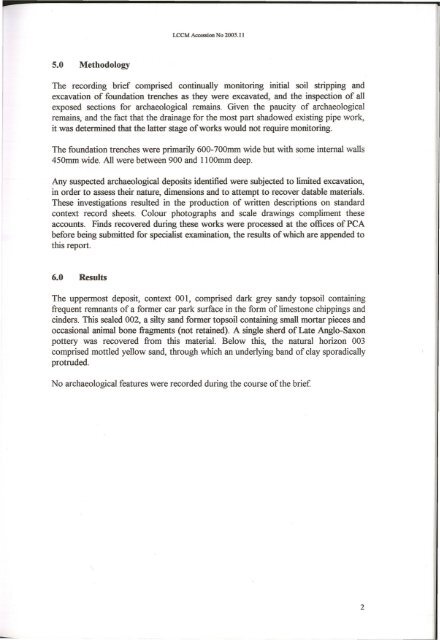land to the rear of the white hart, blyton, lincolnshire. archaeological ...
land to the rear of the white hart, blyton, lincolnshire. archaeological ...
land to the rear of the white hart, blyton, lincolnshire. archaeological ...
You also want an ePaper? Increase the reach of your titles
YUMPU automatically turns print PDFs into web optimized ePapers that Google loves.
5.0 Methodology<br />
LCCM Accession No 2005.11<br />
The recording brief comprised continually moni<strong>to</strong>ring initial soil stripping and<br />
excavation <strong>of</strong> foundation trenches as <strong>the</strong>y were excavated, and <strong>the</strong> inspection <strong>of</strong> all<br />
exposed sections for <strong>archaeological</strong> remains. Given <strong>the</strong> paucity <strong>of</strong> <strong>archaeological</strong><br />
remains, and <strong>the</strong> fact that <strong>the</strong> drainage for <strong>the</strong> most part shadowed existing pipe work,<br />
it was determined that <strong>the</strong> latter stage <strong>of</strong> works would not require moni<strong>to</strong>ring.<br />
The foundation trenches were primarily 600-700mm wide but with some internal walls<br />
450mm wide. All were between 900 and 1100mm deep.<br />
Any suspected <strong>archaeological</strong> deposits identified were subjected <strong>to</strong> limited excavation,<br />
in order <strong>to</strong> assess <strong>the</strong>ir nature, dimensions and <strong>to</strong> attempt <strong>to</strong> recover datable materials.<br />
These investigations resulted in <strong>the</strong> production <strong>of</strong> written descriptions on standard<br />
context record sheets. Colour pho<strong>to</strong>graphs and scale drawings compliment <strong>the</strong>se<br />
accounts. Finds recovered during <strong>the</strong>se works were processed at <strong>the</strong> <strong>of</strong>fices <strong>of</strong> PCA<br />
before being submitted for specialist examination, <strong>the</strong> results <strong>of</strong> which are appended <strong>to</strong><br />
this report.<br />
6.0 Results<br />
The uppermost deposit, context 001, comprised dark grey sandy <strong>to</strong>psoil containing<br />
frequent remnants <strong>of</strong> a former car park surface in <strong>the</strong> form <strong>of</strong> limes<strong>to</strong>ne chippings and<br />
cinders. This sealed 002, a silty sand former <strong>to</strong>psoil containing small mortar pieces and<br />
occasional animal bone fragments (not retained). A single sherd <strong>of</strong> Late Anglo-Saxon<br />
pottery was recovered from this material. Below this, <strong>the</strong> natural horizon 003<br />
comprised mottled yellow sand, through which an underlying band <strong>of</strong> clay sporadically<br />
protruded.<br />
No <strong>archaeological</strong> features were recorded during <strong>the</strong> course <strong>of</strong> <strong>the</strong> brief.<br />
2

















